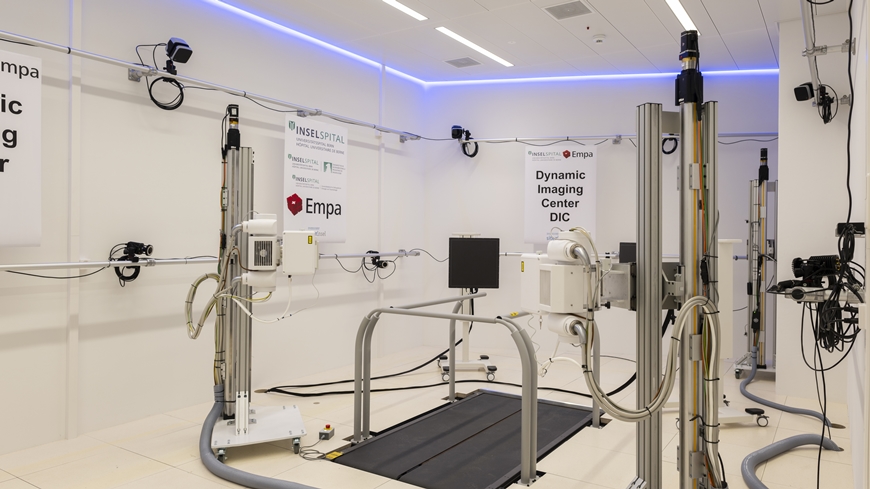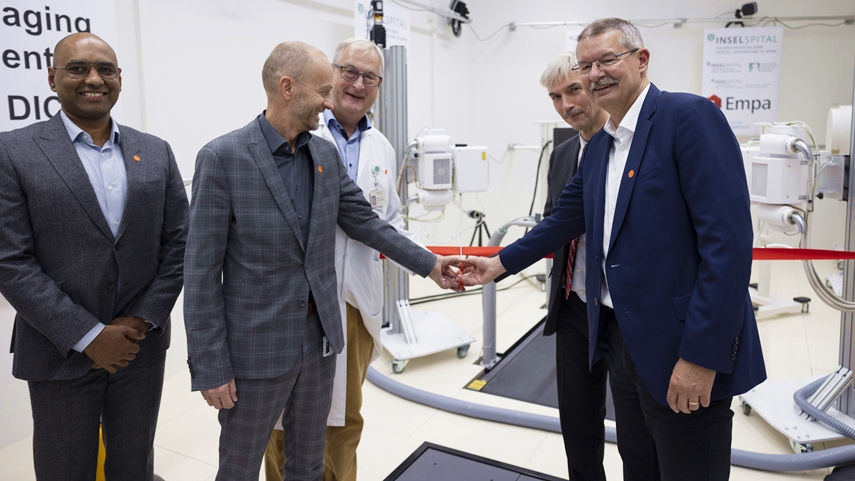Opening of the Dynamic Imaging Center at sitem-insel
Moving X-ray images of the musculoskeletal system
Today, the Dynamic Imaging Center at sitem-insel, the Swiss Institute for Translational Medicine and Entrepreneurship, opened its doors. Here, for the first time, X-ray images of a moving person can be taken simultaneously from two different directions. This enables clinical research that is unique in Europe and that represents a milestone in the investigation of musculoskeletal disorders. The newly founded center is the result of close collaboration between Inselspital and Empa. Inselspital provides the medical knowledge, while Empa contributes its expertise in biomechanical modeling and image processing. The center's infrastructure and operations are financed jointly.

Constantly changing posture is central to the human musculoskeletal system. And yet patients have to stand or lie still for X-ray, computer tomography (CT) and magnetic resonance imaging (MRI) scans. "The 'please don't move' rule in medical imaging makes it difficult to diagnose many diseases of the musculoskeletal system, for example musculoskeletal pain in the shoulder, back or osteoarthritis of the knee," explains Johannes Heverhagen from Inselspital, Bern University Hospital. "If we could take the images while the patient is moving, we could better diagnose diseases that are currently very difficult to detect."
Innovative technology

This is why Heverhagen, together with his colleagues Klaus Siebenrock and Keivan Daneshvar from Inselspital, Bern University Hospital, in close collaboration with Empa researcher Ameet Aiyangar and sitem-insel, established the Dynamic Imaging Center (DIC), which was opened on 10 November as a laboratory unit that is unique in Europe thanks to the ideal conditions at sitem-insel.
Test subjects move either on a treadmill equipped with force sensors or on force plates. Their movements are recorded by 16 infrared (IR) motion capture cameras, X-rays and a muscle electrogram (EMG). At the heart of the new lab is a unique, dynamic X-ray-based high-speed imaging system called Dynamic Biplane Radiographic Imaging (DBRI). "The DBRI can take up to 1'000 X-ray images per second in two different planes, and at very low radiation doses," explains Empa researcher Aiyangar. "This allows us to measure movements with submillimeter accuracy and detect even the finest rolling and sliding movements in the joint."
The moving X-ray images are not intended to replace three-dimensional images from MRI and CT devices, but to supplement them. All the images together provide a comprehensive picture of the situation in the bone or joint, not only at rest but also in motion. Such images are extremely valuable, especially for joint diseases such as osteoarthritis and joint instability. But they can also help diagnose back pain, which afflicts two out of three Swiss people several times a year, and enable better treatment.
Defective joints
A joint consists of two or more bone ends that are movably connected. They are covered by cartilage which, together with the synovial fluid in the joint space, reduces the friction between the bones. In osteoarthritis, the joint cartilage is damaged by inflammation, underload or overload and breaks down over time. As a result, the affected joints can only be moved with pain. Osteoarthritis can be a cause of back pain, as there is also cartilage and joints between the vertebrae in the spine. However, for many sufferers, the cause of this back pain is not clear, which is why the pain is often only treated symptomatically. In the late stages, there are often only two options: to replace the joint with an implant or to stiffen it surgically. However, a more precise diagnosis of the individual causes of joint pain could enable better treatment.
Musculoskeletal disorders are among the most common diseases in Switzerland. They cause high healthcare costs and severely impair the quality of life of those affected. "The opening of the sitem-insel DIC as one of the first laboratories of its kind in a hospital environment in Europe demonstrates how innovation in imaging enables new research approaches. The DIC is another example of how we enable the implementation of ideas from everyday clinical practice so that they can be used successfully on the market," says Simon Rothen, CEO of sitem-insel.
Diverse plans for the future
The everyday use of the new technology in the hospital is not the only aim of the DIC at sitem-insel. Thanks to the new laboratory unit, research into degenerative diseases of the musculoskeletal system such as osteoarthritis is also to be strengthened. In the long term, those responsible are aiming to collaborate with manufacturers of artificial joints and other orthopaedic implants. The latter could test newly developed implants in the research facility directly in use during movement. This is why Daniel Buser, Chairman of the Board of Directors of sitem-insel, believes that the new research facility has a promising future: "So far, there is nothing equivalent in Europe, and such laboratory units have rarely been used in clinical applications worldwide. We are at the forefront here and are bringing cutting-edge research to the Insel Campus Bern."
The "Dynamic Imaging Center" (DIC)
The University Institute for Diagnostic, Interventional and Pediatric Radiology (DIPR) at the Inselspital, Bern University Hospital, is the owner of the laboratory. The DIPR grants Empa special access rights/rights of use as part of a ten-year cooperation agreement. The aim is also to grant interested external partners access to the laboratory for research activities. The unit is housed at sitem-insel on the Insel Campus Bern. sitem-insel has been significantly involved in the project from the outset and has driven the installation of the new facility, which is unique in Europe. High-resolution imaging processes in the field of research and innovation have a long tradition at sitem-insel. One of the world's most modern Tesla 7 magnetic resonance imaging (MRI) scanners has been located in the basement of sitem-insel since it opened in 2019.
sitem-insel: Accelerating bench to bedside
sitem-insel is the Swiss Institute for Translational Medicine and Entrepreneurship. Its mission is to bring research to patients as quickly as possible and to the highest quality. This means creating structures that make it possible to implement ideas from everyday clinical practice in such a way that they can be used successfully on the market. The boundaries are fluid, the rapid and meaningful networking of players brings success. sitem-insel is located on the Insel Campus Bern and benefits from its proximity to Switzerland's largest university hospital (Inselspital) and the University of Bern. Under one roof, sitem-insel brings together a wide variety of clinical, industrial, research and educational units that pursue innovation for the benefit of patients. The architecture of the 20,000 m2 transparent glass building reflects the idea of openness and multidisciplinary collaboration.
Prof. Dr. Ameet Aiyangar
Mechanical Systems Engineering
Phone +41 58 765 4508
Remigius Nideröst
Empa Communications
Phone +41 58 765 4598
redaktion@empa.ch
Grazia Siliberti
Medienstelle sitem-insel
Phone +41 31 666 44 06
Mobile +41 79 616 86 32
Swiss Institute for Translational and Entrepreneurial Medicine: https://sitem-insel.ch
-
Share






